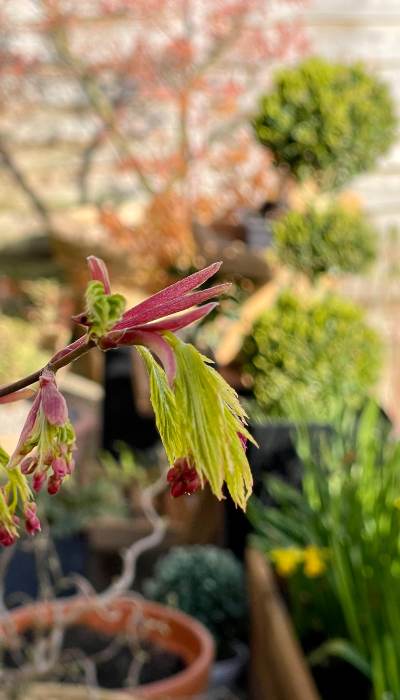Flowering maples, also known as Japanese maples, are easy to care for and quick growing, making them an excellent choice for the beginning gardener. Learn more about how to plant and grow this beautiful flowering tree with our guide to the basics of growing flowering maples below.

Preparing the Garden
To get started, remove any debris from the area you wish to plant your maple. Fill in the hole with the soil that is at least six inches deep. Check for irrigation nearby, then turn on the water. Check for drainage nearby too – this will help make sure water does not pool around the base of your tree causing rot or decay. If there are rocks or other roots already in the hole, go ahead and move them out so that there is room for your tree’s root system.
Since no two soils are alike, it may be a good idea to run a test by filling up some pots with dirt you plan on using – if these plants grow normally after being planted then you’re all set! Be sure to give yourself enough space around the trunk when planting. A minimum of one foot is recommended but more can be used as desired. Add mulch as needed but avoid large pieces that might block airflow and disrupt roots growth
You should now have a beautiful flowering maple tree in your garden!
Preparing the Tree

1. Before planting, the soil should be thoroughly mixed with mulch. Spread at least one inch of topsoil over the entire surface of the area where you are planting.
2. Dig down into the ground in order to create a hole that is two times as wide as your root ball, but only one-third as deep.
3. Pour water onto the roots inside of the pot before removing it from its container and gently set it into place in the hole so that it sinks into it until about two inches below ground level
4. Fill around and on top of your root ball with soil, but make sure there is at least half an inch remaining uncovered above grade.
5. Take mulch or pebbles if necessary to cover any exposed roots.
6. Water well after planting.
7. The maple tree prefers moist but well-drained soil.
8. Feed three times per year with 10-10-10 fertilizer.
9. Irrigate regularly (1/2 gallon per plant per day).
10. As soon as leaves appear, apply a thin layer of composted manure to aid in healthy growth.
11. Remove suckers.
12. Pinch off unwanted branches when they are still small.
13. Apply liquid organic fertilizer twice during the growing season.
14. Use a low phosphate insecticide every month.
15. Maintain shade by using trees, shrubs, or perennials.
16. Prune in late winter.
17. Keep roots cool.
18. Plant out at 20′.
A flowering maple may reach 40 feet tall and 40 feet wide at maturity. Full sun exposure will result in taller plants; partial sun exposure will result in shorter plants.
The species name ‘Acer pseudoplatanus’ refers to the false sycamore figwort, which describes this species’ superficial resemblance to true sycamores. The bark and foliage are very similar between these two types of trees; however, sycamores have oppositely arranged leaves while those of maples alternate along their stems.
Planting and Shaping the Tree
Dig a hole that is deep enough for the tree root system. Once the hole is dug, mix potting soil into the bottom of the hole. If you want to transplant it from a container or other temporary home, set it into the hole at this time. Put rocks or wood inside the hole for drainage. (Add 2-3 inches if your soil mixture does not include drainage material) Set tree in the hole with crown over soil line then cover with topsoil/mulch around roots and backfill until firm.
Be sure not to get too close to the trunk of a tree when backfilling because its bark could become torn off by fresh tilling against it. Remove any wire ties around the trunk after planting by gently cutting them off near ground level with wire cutters. Firmly pack soil around the base of the tree and water the well.
When growing flowering maples make sure that you choose a location where they will receive full sun so they can grow their best! Water every 3-4 days during dry periods but be careful not to overwater which can lead to mold issues. Fertilize once per year in early spring with an organic fertilizer like compost tea. Prune to the desired shape after the tree is three years old to keep the shape neat and remove branches that are blocking sunlight. Don’t prune more than 10% of the new growth each year, as this may stress out the tree.
The Final Step

Your patience has been rewarded! Your beautiful new flowering maple tree is almost ready for planting. Follow these steps:
1) Dig a hole
2) Place the container in the center of the hole
3) Turn over the container
4) Remove the tree from the pot
5) Set your tree on its root ball, this way you can see where it is set
6) Fill in soil around the root ball so that it’s level with the top of the root ball, cover roots with remaining soil
7) Water
8) Add fertilizer (optional, but recommended). Congratulations on your newly planted tree!
Is flowering maple a houseplant?
Maple trees are not usually grown as houseplants because they grow rather large. They will typically have to be removed from the container when their root ball becomes too big. However, there are ways you can keep them inside for short periods of time before transplanting them outside, or keeping them in a pot that’s constantly being watered.
For example, if you want to use your maple tree as an indoor decoration during the winter season, it will need at least 10 hours of sunlight every day (but preferably more). If you do choose to keep it indoors, make sure that there is plenty of airflow around the tree in order for it not to get too hot.
Can you propagate a flowering maple?
As it turns out, maples can be propagated from cuttings! This is great news for those with small yards who want to maximize the beauty of their yard. When I stumbled across this, I was thrilled because I wanted one of these but only had space for a little container! The downside is that propagating maples will make them develop an inferior root system in comparison to seedlings. They are also susceptible to drought since they have such shallow roots, but given the right amount of water, they can develop deep enough roots within two years.
How often should I water flowering maple?
Flowering maples do not require as much watering as many other trees. You should water about once every two weeks for the first month. That gives your tree time to establish its root system before requiring more water. After the first month, you should water your tree when the top inch of soil dries out. Another key factor in determining when to water is the ambient air temperature during the day or night. If it is warm outside, you need less water than if it were cold outside due to increased transpiration rates by plants.
Always remember that overwatering your tree can be just as bad as underwatering it.
What should I feed my flowering maple?
All maples need water; this needs to be an ongoing task, not just an annual event. And the soil needs to stay moist all the time, in fact for many people with flowering maples or other types of trees, the best way is to have what is called a drip irrigation system installed so that you never have dry pockets in your soil. You also need something called fertilizer.
Some maples will only require fertilizer once or twice during their lifetime, but for others, it might be necessary several times per year. There are four primary different types of fertilizer: root feeders, nitrogen fertilizers, phosphorus fertilizers, and iron nitrate fertilizers. For most flowering maples these will be used at differing rates depending on your specific type of maple tree.
Why is my flowering maple losing leaves?
One possible reason for your flowering maple losing leaves is weather conditions. The Mapa, like all other plants, needs sunlight to grow but can be harmed by the wind. Another probable cause of leaf loss is extreme heat or frost. If you notice the leaves on your maple becoming yellow or withering, take it indoors as soon as possible so it does not suffer any more damage.
Keep the mapa out of direct sunlight for two weeks until it has completely recovered. Finally, soil preparation is important when planting a flowering maple tree because it provides nutrients and helps maintain the mapa’s moisture level. Some recommendations for fertilizer include bone meal, manure, or compost.
Conclusion
Maple trees are simple enough to grow that people may not need the help of professionals. People who live in regions with cold winters will want to make sure they purchase maples or shrubs that enjoy the colder climates. These climates can include ones that have less than 10 degrees Celsius in the winter months. Purchasing small maples is a good idea for those who are unsure of what type of tree they would like, as well as those who may be unsure about growing a maple tree.
In conclusion, planting and growing trees like maples is an easy way for people to beautify their property with color during the autumn season as well as shade during the summertime.
Also, check out the latest articles “Coffee plant” and “Pitcher plants“
Hi I’m Bilal Malik, a digital marketing and blogging expert holding years of experience.










